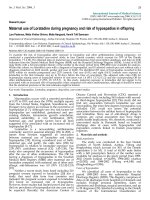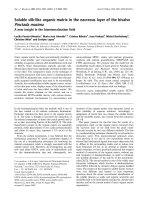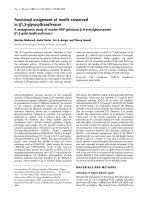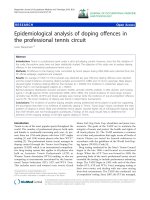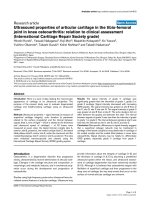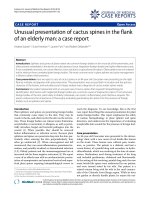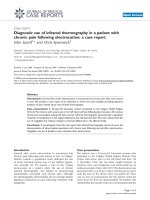Báo cáo y học: " Rational use of computerized protocols in the intensive care unit" ppt
Bạn đang xem bản rút gọn của tài liệu. Xem và tải ngay bản đầy đủ của tài liệu tại đây (57.06 KB, 6 trang )
ARDS = acute respiratory distress syndrome; ECF = extracellular fluid volume; ICU = intensive care unit.
Available online />Critical care decision-support tools can focus on diagnostic
[1], administrative [2], or therapeutic needs. Decision-support
tools have been functionally categorized as ‘reminders,’ ‘con-
sultants,’ or ‘educational’ [3]. These three categories do not
embrace the intensive care unit (ICU) treatment management
or titration protocols used to apply explicit methods of
mechanical ventilation [4–6] and fluid and hemodynamic
support [7,8] in patients with acute lung injury or acute respi-
ratory distress syndrome (ARDS). In this review I focus on
these management or titration protocols and consider several
rationales for the use of such explicit detailed computerized
protocols in the ICU. I discuss the features of computerized
ICU protocols that distinguish them from other decision-
support tools such as guidelines, paper protocols, and clini-
cal or nursing or critical paths. These protocols complement,
but do not replace, the ICU decision-maker.
Varieties of decision-support tools
Thousands of decision-support tools with different names,
foci, and outputs are available but they often lack specific
instructions for many of the situations encountered in clinical
practice [9]. Most are useful only in a conceptual sense
[10–16]. They neither standardize clinical decisions nor lead
to a uniform implementation of clinical interventions, although
standardization and uniformity are their goals [14,16,17]. For
example, it would be difficult to reduce variability with a proto-
col that required the clinician to determine whether the
patient ‘looked septic,’ unless the state ‘looked septic’ were
explicitly defined. Computerized protocols used for complex
clinical problems can contain much more detail than is possi-
ble with textual guidelines or with paper-based flow diagrams
[16]. The increased detail allows the generation, at the point
of care, of patient-specific therapy instructions that can be
performed by different clinicians with almost no inter-clinician
variability [18]. This can make both formal clinical inquiries
(for example, randomized trials) and informal clinical inquiries
(for example, some continuous quality improvement efforts, or
clinical practice evaluations) more robust [9,18].
Reducing clinician variability might seem to challenge the
importance that clinicians assign to individualized (patient-
specific) therapy. Unexpectedly, individualization of patient
therapy is preserved when clinical decisions are standardized
with explicit, detailed, patient-data-driven, computerized pro-
tocols [9,19]. An essential element in achieving this unex-
pected result is the use of patient data (that is, the patient’s
unique expression of the disease) to drive the decision-
support tool (protocol) rules. Unlike these specific patient-
Review
Rational use of computerized protocols in the intensive care unit
Alan H Morris
LDS Hospital and University of Utah School of Medicine, Salt Lake City, USA
Correspondence: Alan H Morris, MD,
Published online: 13 September 2001
Critical Care 2001, 5:249-254
© 2001 BioMed Central Ltd (Print ISSN 1364-8535; Online ISSN 1466-609X)
Abstract
Excess information in complex ICU environments exceeds human decision making limits, increasing the
likelihood of clinical errors. Explicit decision-support tools have favorable effects on clinician and
patient outcomes and can reduce the variation in clinical practice that persists even when guidelines
based on reputable evidence are available. Computerized protocols used for complex clinical problems
generate, at the point-of-care, patient-specific evidence-based therapy instructions that can be carried
out by different clinicians with almost no inter-clinician variability. Individualization of patient therapy is
preserved by these explicit protocols since they are driven by patient data. Computerized protocols
that aid ICU decision-makers should be more widely distributed.
Keywords decision-support, intensive care, protocols, research, safety
commentary
review
reports research
Critical Care October 2001 Vol 5 No 5 Morris
data-driven explicit methods [4,5,20–25], time-driven deci-
sion-support tools (for example a clinical path that requires
discharge of the patient after 3 days of care) raise legitimate
concerns about patient-invariant (‘cookbook’) care. Individual-
izing patient care while standardizing clinical decisions with
an explicit method is, in my opinion, one of the most attractive
attributes of the point-of-care use of computerized protocols.
Why is there need for protocols in the ICU?
Clinical error rates are common (about 1–50%) [26–53]. This
is an expression of the general problem: that human error and
injury are unavoidable [27,35,54,55]. Even when ICU errors
represent only 1% of clinical decisions [53] and therefore indi-
cate little room for personal improvement (in that 99% of deci-
sions are correct), clinical ICU errors and injuries that threaten
patient safety occur with distressing frequency [44,53].
Variation in clinical practice persists even when guidelines
based on reputable evidence are available [28,29], and
patients can be harmed when clinicians do not comply with
standard practice [9,30,31]. Widespread distribution of evi-
dence-based guidelines [35,36] and education programs
[24,37–40] has had only a limited effect on low compliance
by clinicians. Variability is fostered by incorrect perceptions.
The perceptions of physicians in their use of physiological
data and the actual use of such data in decision-making for
cardiac problems in the ICU are internally inconsistent
(within-decision-maker inconsistency) [56]. This is in part due
to the use of ill-defined terms or statements such as
‘…caution should be exercised when PAOP [pulmonary
artery occlusion pressure] becomes increased to the extent
that pulmonary edema is a risk’ [57]. This particular inconsis-
tency appeared in a journal issue containing three articles
that presented mutually contradictory sets of recommenda-
tions about hemodynamic monitoring (between-decision-
maker inconsistency) [58].
Variation in practices with ICU fluids and electrolytes illus-
trates the confusion propagated by the imprecise use of
words and concepts in medicine. An analytical scheme
addressing three major factors in fluid and electrolyte evalua-
tion (1, effectiveness of the arterial circulation; 2, extracellular
fluid volume [ECF]; and 3, state of hydration [59]) is compati-
ble with widely taught precepts [60–67]. Evaluating these
three concepts separately is important for clarifying problems
with fluids and electrolytes and thereby for reducing unneces-
sary variation. Use of fluid and electrolyte terms in a nonstan-
dardized manner leads to confusion. An American Medical
Association Council report cites isotonic, hypertonic, and
hypotonic dehydration, thereby confusing the evaluation of
the state of the ECF and the state of hydration [68]. Cardio-
vascular evaluation is also (inappropriately) included in the
evaluation of hydration, thereby confusing the evaluation of
the effectiveness of the arterial circulation (cardiovascular
evaluation) with the evaluation of the state of hydration.
Hypernatremic dehydration (a tautology if standard definitions
are used) was used to describe both dehydration (hyperna-
tremia) and ECF contraction [69]. For patients with traumatic
brain injury, dehydration was used in two contradictory ways
[70]. First, the authors recommended inducing dehydration
with mannitol (producing dehydration or underhydration
according to the standard terminology) because it was
effective in reducing intracranial pressure. They then recom-
mended avoiding dehydration with diuretics (producing ECF
contraction due to negative fluid balance) because it was
ineffective in reducing intracranial pressure [70]. The use and
the teaching of terms in such contradictory ways probably
contribute to the uncertainty surrounding fluid and electrolyte
therapy for sepsis [71], shock [72–74] and ARDS [75]. Fluid
and electrolyte therapy is an important and uncontrolled co-
intervention that can influence patient outcome and obscure
the effects of therapeutic interventions in clinical trials.
Protocols enhance efficiency, safety, and
efficacy of care
Efficiency is the term assigned to the evaluation of resource
consumption for a clinical intervention accepted as part of
routine practice. At the individual patient level, standardization
enhances efficiency by making the clinical plan explicit to all
providers dealing with that patient. Nurses, therapist, and
physicians thereby achieve a level of uniformity of approach
and goals for the specific patient. This reduces within-patient
variability of decision-making. However, this does not reduce
unnecessary variation between patients and between physi-
cians. Standardized clinical decisions are important at several
levels within the healthcare delivery system.
Human decision-making limitations, perceptual inaccuracies,
and variation in the use and in the interpretation of important
clinical variables all make clinicians unable to consistently
generate therapeutic decisions that are coherent, that con-
sider all appropriate options, and that are based on the rele-
vant scientific evidence [27,34,35,43,44,46,76–79]. For
example, adverse drug events are common, costly, and
largely preventable causes of excess morbidity and mortality
in ICU patients [25,80–82]. Estimates of the annual national
cost of adverse drug events in the USA run as high as US
$79 billion to US $136 billion [25,83]. Unfortunately, adverse
drug events are generally undetected. Traditional screening
for in-hospital adverse drug events detects only 1% and vol-
untary reporting only 12% of the adverse drug events
detected by automated computerized screening of an inte-
grated electronic clinical database [84].
Even when the healthcare community understands the proper
approach, compliance of physicians with evidence-based
treatments or guidelines is low across a broad range of
healthcare topics [20,85–89]. Patient [90] and hospital [91]
compliance is approximately as low. Only about 50% of
patients with chronic diseases receive effective delivery of
their therapy [90]. Like low compliance by clinicians, this
seems to be a feature of our human condition. In contrast,
commentary
review
reports research
both paper-based and computerized decision-support tools
that provide explicit, point-of-care (point-of-decision-making)
instructions to clinicians have overcome many problems and
have achieved clinician compliance rates of 90–95%
[5,19,92]. However, the absence of requisite infrastructure in
the ICU environment is an important obstacle to the adoption
of clinical decision-support tools such as those demonstrated
to produce a favorable clinical outcome in a multicenter ran-
domized clinical trial [5,6].
Protocols enable rigorous clinical research
Modern medicine has fostered the development of undoubted
advances. In spite of these and other obvious benefits, only a
small fraction of current clinical practice has been shown to
produce more good than harm [18,32–34]. Some important
problems in critical care have long resisted resolution. While
our understanding of underlying mechanisms of injury and
inflammation in sepsis and ARDS has blossomed, our under-
standing of clinical management of sepsis and ARDS has not.
Several clinical trials of promising therapeutic agents have
consistently failed to identify the promised advances in therapy
[21,93–98]. The absence of a clear benefit from this broad
spectrum of tested interventions suggests that the clinical
problems are insoluble and cannot be improved, or that the
needed interventions have not yet been tested, or that our clin-
ical investigative strategy is not sound. We have all been
encouraged by recent advances in the treatment of patients
needing mechanical ventilation [92] and those with sepsis
[99], but our success rate with clinical trials that produce
important clinical advances is disappointingly low.
Standardization of clinical decisions is needed not only for
clinical practice but also for rigorous clinical research [49].
Many interventions of clinical value have relatively small
effects, with odds ratios of 3.0 or less [50]. Systematically
conducted clinical trials are necessary for these small effects
to be recognized and for ineffective clinical care elements to
be identified [50,51]. However, without explicit methods the
fundamental scientific requirement of replicability of results
[48,49] cannot be achieved. An explicit method, driven by
patient data, contains enough detail to generate specific
instructions (patient-specific orders) without requiring judg-
ments by a clinician. Any form of guideline or protocol can
theoretically contain enough detail to constitute an explicit
method. In practice, however, paper-based versions of any
protocols except the simplest (for example, vaccination
schedules or treatment of hypokalemia in a patient receiving
digitalis and diuretics) cannot be made explicit and therefore
remain dependent on the judgment of a clinician.
Protocols enhance education
If explicit computerized protocols lead clinical trainees to
abandon critical thinking, they might contribute to the produc-
tion of clinicians less prepared for the rigorous intellectual
challenge of healthcare delivery. For those afraid of demean-
ing the clinical training of students and house officers, I
respond that an explicit method, when used wisely, can be an
effective tool for teaching students the principles both of
decision-making and of clinical practice. Unlike much tradi-
tional clinical teaching, explicit decision-support tools articu-
late both the variables considered and the decision rules. In
an environment dedicated to training, explicit methods can be
an asset. In an environment that pays little heed to training,
they could be a disadvantage. Like any tool, guidelines can
be misused. Finally, many physicians are concerned about a
reduction of their role in medical practice and of the potential
disenchantment of physicians with medicine that could follow
the widespread mandatory use of guidelines and protocols
[15]. Standardization might be perceived as an attack on clin-
icians’ assumption that they possess special and ineffable
wisdom in clinical matters and on its corollary that patients
receive the best outcome when physicians independently use
their best clinical judgment [100,101]. It is this belief, namely
that expert ICU physicians possess special and ineffable
wisdom, that interferes with the education of young physi-
cians, by avoiding the challenge of articulating precisely how
decisions should be made.
Summary
The excess information in complex ICU environments
exceeds human decision-making limits, increasing the likeli-
hood of clinical errors. Explicit decision-support tools have
favorable effects on the clinician and on patient outcomes.
They have been implemented in diverse clinical environments
and have been successfully transferred and used in geo-
graphically dispersed ICUs that were not involved in their
initial development. However, various human factors and the
paucity of distributed electronic clinical databases impede
the widespread distribution of clinical decision-support tools.
Notwithstanding these challenges, the documented benefit of
the application of decision-support tools in the ICU and the
rapid expansion of electronic ICU databases promise an
increasingly favorable environment for the development,
implementation, and use of computerized protocols to aid
clinical decision-makers in the ICU.
Competing interests
None declared.
Acknowledgements
I am indebted to the medical, nursing, and respiratory therapy staffs of
the Intermountain Respiratory Intensive Care Unit and of the Shock-
Trauma/Intermountain Respiratory ICU, and to the Respiratory Care
Department of the LDS Hospital, for collaboration during the past 25
years. I recognize the contributions of Dr James Orme, Jr, Dr Terry
Clemmer, Dr Lindell Weaver, Dr Frank Thomas, Dr Tom East, Dr Jane
Wallace, Dr George Thomsen, Dr James Pearl, Dr Nat Dean, and Dr
Brad Rasmusson for collaboration in protocol development and imple-
mentation. Finally, I express my gratitude to Dr Roberta Goldring, Dr
Robert Rogers, and Dr Waldemar Johanson, who, through their vision
and insight, enabled the decision-support effort that has engaged my
colleagues and me for the past 16 years. This work was supported by
the NIH (RO1-HL-36787, NO1-HR-46062), the AHCPR (HS 06594),
the Deseret Foundation, the Respiratory Distress Syndrome Founda-
tion, the LDS Hospital, and IHC, Inc.
Available online />References
1. Squara P, Journois D, Formela JF, Schremmer B, Dhainaut JF, Ble-
ichner G: Value of elementary, combined, and modeled hemo-
dynamic variables. J Crit Care 1994, 9:223-235.
2. Berenholtz S, Pronovost P, Lipsett P, Dawson P, Dorman T:
Assessing the effectiveness of critical pathways on reducing
resource utilization in the surgical intensive care unit. Inten-
sive Care Med 2001, 27:1029-1036.
3. Miller R, Goodman K: Ethical challenges in the use of decision-
support software in clinical practice. In Ethics, Computing, and
Medicine: Informatics and the Transformation of Health Care.
Edited by Goodman K. Cambridge, UK: Cambridge University
Press; 1998:102-115.
4. East TD, Böhm SH, Wallace CJ, Clemmer TP, Weaver LK, Orme
JF, Jr, Morris AH: A successful computerized protocol for clini-
cal management of pressure control inverse ratio ventilation
in ARDS patients. Chest 1992, 101:697-710.
5. East T, Heermann L, Bradshaw R, Lugo A, Sailors R, Ershler L,
Wallace C, Morris A, McKinley G, Marquez A, Tonnesen A,
Parmley L, Shoemaker W, Meade P, Taut P, Hill T, Young M,
Baughman J, Olterman M, Gooder V, Quinnj B, Summer W,
Valentine V, Carlson J, Bonnell B, deBoisblanc B, McClarity Z,
Cachere J, Kovitz K, Gallagher E, Pinsky M, Angus D, Cohenj M,
Hudson L, Steinberg K: Efficacy of computerized decision
support for mechanical ventilation: results of a prospective
multi-center randomized trial. Proc AMIA Symp. 1999:251-
255.
6. McKinley BA, Moore FA, Sailors RM, Cocanour CS, Marquez A,
Wright RK, Tonnesen AS, Wallace CJ, Morris AH, East TD: Com-
puterized decision support for mechanical ventilation of
trauma induced ARDS: results of a randomized clinical trial. J
Trauma 2001, 50:415-424; discussion 425.
7. Morris A: Evaluating and refining a hemodynamic protocol for
use in a multicenter ARDS clinical trial [abstract]. Am J Resp
Crit Care Med (ATS Proceedings Abstracts) 2000, 161:A378.
8. East T, Morris A: A report instrument for refining computerized
protocols [abstract]. Am J Resp Crit Care Med (ATS Proceed-
ings Abstracts) 2001, 163:A259.
9. Morris A: Algorithm-based decision making. In Principles and
Practice of Intensive Care Monitoring. Edited by Tobin M. New
York: McGraw-Hill, Inc.; 1998:1355-1381.
10. Audet A-M, Greenfield S, Field M: Medical practice guidelines:
current activities and future directions. Ann Intern Med 1990,
113:709-714.
11. Fletcher R, Fletcher S: Clinical practice guidelines. Ann Intern
Med 1990, 113:645-646.
12. Hadorn D, McCormick K, Diokno A: An annotated algorithm
approach to clinical guideline development. JAMA 1992, 267:
3311-3314.
13. Miller P, Frawly S: Trade-offs in producing patient-specific rec-
ommendations from a computer-based clinical guideline: a
case study. J Am Med Informatics Assoc 1995, 2:238-242.
14. Fridsma D, Gennari J, Musen M: Making generic guidelines site-
specific. In Proceedings of the 1996 AMIA Annual Fall Sympo-
sium. Edited by Cimino J. Washington, DC: Hanley & Belfus, Inc.;
1996:597-601.
15. Tierney WM, Overhage JM, McDonald CJ: Computerizing guide-
lines: factors for success. In Proceedings 1996 AMIA Annual
Fall Symposium. Edited by Cimino J. Washington, DC: Hanley &
Belfus, Inc.; 1996:459-462.
16. Tierney WM, Overhage JM, Takesue BY, Harris LE, Murray MD,
Vargo DL, McDonald CJ: Computerizing guidelines to improve
care and patient outcomes: the example of heart failure. J Am
Med Informatics Assoc 1995, 2:316-322.
17. Field M, Lohr K (Eds): Clinical practice guidelines: directions
for a new program (summary). Washington, DC: National
Academy Press; 1990.
18. Morris A, Cook D: Mechanical ventilation clinical trial issues. In
Physiologic Basis of Ventilatory Support. Edited by Marini J,
Slutsky A. New York: Marcel Dekker, Inc.; 1998:1359-1398.
19. Morris A: Developing and implementing computerized proto-
cols for standardization of clinical decisions. Ann Intern Med
2000, 132:373-383.
20. Evans RS, Pestotnik SL, Classen DC, Clemmer TP, Weaver LK,
Orme JF Jr, Lloyd JF, Burke JP: A computer-assisted manage-
ment program for antibiotics and other antiinfective agents. N
Engl J Med 1998, 338:232-238.
21. Morris A, Wallace C, Menlove R, Clemmer T, Orme JJ, Weaver L,
Dean N, Thomas F, East T, Suchyta M, Beck E, Bombino M, Sittig
D, Böhm S, Hoffmann B, Becks H, Pace N, Butler S, Pearl J, Ras-
musson B: Randomized clinical trial of pressure-controlled
inverse ratio ventilation and extracorporeal CO
2
removal for
ARDS. Am J Respir Crit Care Med 1994, 149:295-305. (Erratum,
1994, 149:838.)
22. East T: Role of the computer in the delivery of mechanical
ventilation. In Principles and Practice of Mechanical Ventilation.
Edited by Tobin M. New York: McGraw-Hill, Inc.; 1994:1005-
1038.
23. Classen DC, Evans RS, Pestotnik SL, Horn SD, Menlove RL,
Burke JP: The timing of prophylactic administration of antibi-
otics and the risk of surgical-wound infection. N Engl J Med
1992, 326:281-286.
24. Pestotnik S, Classen D, Evans R, Burke J: Implementing antibi-
otic practice guidelines through computer-assisted decision
support: clinical and financial outcomes. Ann Intern Med 1996,
124:884-890.
25. Classen DC, Pestotnik SL, Evans RS, Lloyd JF, Burke JP:
Adverse drug events in hospitalized patients: excess length
of stay, extra costs, and attributable mortality. JAMA 1997,
277:301-306.
26. Williamson J, Goldschmidt P, Jillson I: Medical Practice Informa-
tion Demonstration Project—Final Report (Contract #282-77-
0068GS). Baltimore, MD: Office of the Assistant Secretary of
Health, DHEW; 1979.
27. Abramson NS, Wald KS, Grenvik ANA, Robinson D, Snyder JV:
Adverse occurrences in intensive care units. JAMA 1980, 244:
1582-1584.
28. McDonald CJ, Wilson GA, McCabe G Jr: Physician response to
computer reminders. JAMA 1980, 244:1579-1581.
29. West J: An autopsy method for evaluating trauma care. J
Trauma 1981, 21:32-34.
30. Morris AH, Chapman RH, Gardner RM: Frequency of technical
problems encountered in the measurement of pulmonary
artery wedge pressure. Crit Care Med 1984, 12:164-170.
31. Morris AH: Elimination of pulmonary wedge pressure errors
commonly encountered in the ICU. Cardiologia (Italy) 1985, 30:
941-943.
32. Browner W, Newman T: The analogy between diagnostic tests
and clinical research. JAMA 1987, 257:2459-2463.
33. Physicians ACo: Working conditions and supervision for resi-
dents in internal medicine programs: recommendations. Ann
Intern Med 1989, 110:657-663.
34. Iberti T, Fischer E, Leibowitz M, Panacek E, Silverstein J, Albertson
T, Group PACS: A multicenter study of physician’s knowledge
of the pulmonary artery catheter. JAMA 1990, 264:2928-2932.
35. Wu A, Folkman S, McPhee S, Lo B: Do house officers learn
from their mistakes? JAMA 1991, 265:2089-2094.
36. Brook R: Using scientific information to improve quality of
health care. In Doing More Good than Harm: the Evaluation of
Health Care Interventions. Edited by Warren K, Mosteller F. New
York: The New York Academy of Sciences; 1993:74-85.
37. Chalmers T, Lau J: Randomized controlled trials and meta-
anlayses in gastroenterology: major achievements and future
potential. In Doing More Good than Harm: the Evaluation of
Health Care Interventions. Edited by Warren K, Mosteller F. New
York: The New York Academy of Sciences; 1993:96-106.
38. Chan L, Schonfeld N: How much information is lost during pro-
cessing: a case study of emergency department records.
Comput Biomed Res 1993, 26:582-591.
39. McNeil B: Use of claims data to monitor patients over time:
acute myocardial infarction as a case study. In Doing More
Good than Harm: the Evaluation of Health Care Interventions.
Edited by Warren K, Mosteller F. New York: The New York
Academy of Sciences; 1993:63-73.
40. O’Connor G, Plume S, Wennberg J: Regional organization for
outcomes research. In Doing More Good than Harm: the Evalu-
ation of Health Care Interventions. Edited by Warren K, Mosteller
F. New York: The New York Academy of Sciences; 1993:44-51.
41. Warren K, Mosteller F (Ed): Doing More Good than Harm: the
Evaluation of Health Care Interventions. New York: The New York
Academy of Sciences; 1993.
42. Wennberg J, Barry M, Fowler F, Mulley A: Outcomes research,
PORTs, and health care reform. In Doing More Good than
Harm: the Evaluation of Health Care Interventions. Edited by
Critical Care October 2001 Vol 5 No 5 Morris
Warren K, Mosteller F. New York: The New York Academy of Sci-
ences; 1993:52-62.
43. Iberti TJ, Daily EK, Leibowitz AB, Schecter CB, Fischer EP, Silver-
stein JH: Assessment of critical care nurses’ knowledge of the
pulmonary artery catheter. The Pulmonary Artery Catheter
Study Group. Crit Care Med 1994, 22:1674-1678.
44. Leape L: Error in medicine. JAMA 1994, 272:1851-1857.
45. Tyson NdG. Signal versus noise. Nat Hist 1996, 105:72-76.
46. Gnaegi A, Feihl F, Perret C: Intensive care physicians’ insuffi-
cient knowledge of right-heart catheterization at the bedside:
time to act? Crit Care Med 1997, 25:213-220.
47. Schulz E, Barrett J, Price C: Read Code quality assurance: from
simple syntax to semantic stability. J Am Med Inform Assoc
1998, 5:337-346.
48. Sudeep N, Anuradha L, Obasanjo O, Chaisson R: Errors in the
treatment of tuberculosis in Baltimore. Chest 2000, 117:734-
737.
49. Palevsky PM, Bhagrath R, Greenberg A: Hypernatremia in hos-
pitalized patients. Ann Intern Med 1996, 124:197-203.
50. Kohn L, Corrigan J, Donaldson M (Ed): To Err is Human—Building
a Safer Health System. Washington, DC: National Academy
Press; 1999.
51. Nakhleh RE, Zarbo RJ: Amended reports in surgical pathology
and implications for diagnostic error detection and avoidance:
a College of American Pathologists Q-probes study of
1,667,547 accessioned cases in 359 laboratories. Arch Pathol
Lab Med 1998, 122:303-309.
52. Krizek TJ: Surgical error: ethical issues of adverse events. Arch
Surg 2000, 135:1359-1366.
53. Gopher D, Olin M, Badihi Y, Cohen G, Donchin Y, Sieski M,
Cotev S: The nature and causes of human errors in a medical
intensive care unit. In Proceedings of the Human Factors and
Ergonomics Society Annual Meeting, 1989:956-960.
54. Reason J: Human Error. Cambridge, UK: Cambridge University
Press; 1990.
55. Reason J: Human error: models and management. Br Med J
2000, 320:768-770.
56. Ontario Intensive Care Study Group: Evaluation of right heart
catheterization in critically ill patients. Crit Care Med 1992, 20:
928-933.
57. Guidelines Committee Society of Critical Care Medicine: Guide-
lines for the care of patients with hemodynamic instability
associated with sepsis. Crit Care Med 1992, 20:1057-1059.
58. Morris A: Hemodynamic guidelines. Crit Care Med 1993, 21:
1096.
59. Palevsky P, Bhagrath R, Greenberg A: Hypernatremia in hospi-
talized patients. Ann Intern Med 1996, 124:197-203.
60. Feig P, McCurdy D: The hypertonic state. N Engl J Med 1977,
297:1444-1454.
61. Windus D: Fluids and electrolyte management. In Manual of
Medical Therapeutics, edn 25. Edited by Orland M, Saltman R.
Boston: Little, Brown and Company; 1986:40-56.
62. Levinsky N: Fluids and electrolytes. In Harrison’s Principles of
Internal Medicine, edn 12. Edited by Wilson J, Braunwald E, Issel-
bacher K, Petersdorf R, Martin J, Fauci A, Root R. New York:
McGraw-Hill, Inc.; 1991:278-283.
63. DeVita M, Michelis M: Perturbations in sodium balance. Clin
Lab Med 1993, 13:135-148.
64. Rose B: Clinical physiology of Acid–Base and electrolyte disor-
ders, edn 4. New York: McGraw-Hill, Inc.; 1994.
65. Mange K, Matsuura D, Cizman B, Soto H, Ziyadeh FN, Goldfarb
S, Neilson EG: Language guiding therapy: the case of dehy-
dration versus volume depletion. Ann Intern Med 1997,
197:848-852.
66. Vanatta J, Fogelman M: Moyer’s Fluid Balance—a Clinical Manual,
edn 4. Chicago: Year Book Medical Publishers, Inc.; 1988.
67. Weaver L, Hopkins R, Churchill S, Chan K, Morris AH, Clemmer
T, Elliott C, Orme J, Thomas F, Haberstock D: Outcome of acute
carbon monoxide poisoning treated with hyperbaric or nor-
mobaric oxygen (double-blind) [abstract]. Am J Resp Crit Care
Med (ATS Proceedings Abstracts) 2001, 163:A16.
68. Weinberg A, Minaker K: Dehydration. Evaluation and manage-
ment in older adults. JAMA 1995, 274:1552-1556.
69. Chilton L: Prevention and management of hypernatremic dehy-
dration in breast-fed infants. West J Med 1995, 163:74-76.
70. Zornow M, Prough D: Fluid management in patients with trau-
matic brain injury. New Horizons 1995, 3:488-498.
71. Thijs L: Fluid therapy in septic shock. In Clinical Trials for the
Treatment of Sepsis. Edited by Sibbald W, Vincent J-L. Berlin:
Springer-Verlag; 1995:167-190.
72. Shoemaker W, Appel P, Kram H: Prospective trial of supranor-
mal values of survivors as therapeutic goals in high risk sur-
gical patients. Chest 1988, 94:1176-1186.
73. Tuchschmidt J, Fried J, Astiz M, Rackow E: Supranormal oxygen
delivery improves mortality in septic shock patients. Crit Care
Med 1991, 19:S66.
74. Shoemaker W, Appel P, Kram H, Bishop M, Abraham E: Tempo-
ral hemodynamic and oxygen transport patterns in medical
patients: septic shock. Chest 1993, 104:1529-1536.
75. Mitchell J, Schuller D, Calandrino F, Schuster D: Improved
outcome based on fluid management in critically ill patients
requiring pulmonary artery catheterization. Am Rev Resp Dis
1992, 145:990-998.
76. Tversky A, Kahneman D: Availability: A heuristic for judging fre-
quency and probability. In Judgment Under Uncertainty: Heuris-
tics and Biases. Edited by Kahneman D, Slovic P, Tversky A.
Cambridge, UK: Cambridge University Press; 1982:163-178.
77. Jennings D, Amabile T, Ross L: Informal covariation assess-
ment: data-based versus theory-based judgments. In Judg-
ment Under Uncertainty: Heuristics and Biases. Edited by
Kahneman D, Slovic P, Tversky A. Cambridge, UK: Cambridge
University Press; 1982:211-230.
78. McDonald CJ: Protocol-based computer reminders, the quality
of care and the non-perfectability of man. N Engl J Med 1976,
295:1351-1355.
79. Pocock SJ: Clinical Trials: A Practical Approach. New York, NY:
John Wiley & Sons; 1983.
80. Avorn J: Putting adverse drug events into perspective (Editor-
ial). JAMA 1997, 277:341-342.
81. Bates D, Spell, N, Cullen D, et al: The costs of adverse drug
events in hospitalized patients. JAMA 1997, 277:307-311.
82. Lesar T, Briceland L, Stein D: Factors related to error in med-
ication prescribing. JAMA 1997, 277:312-317.
83. Johnson J, Bootman J: Drug-related morbidity and mortality; a
cost of illness model. Arh Int Med 1995, 155:1949-1956.
84. Classen DC, Pestotnik SL, Evans RS, Burke JP: Computerized
surveillance of adverse drug events in hospital patients. JAMA
1991, 266:2847-2851.
85. Nelson E, Splaine M, Batalden P, Plume S: Building measure-
ment and data collection into medical practice. Ann Intern Med
1998, 128:460-466.
86. Schacker T, Collier AC, Hughes J, Shea T, Corey L: Clinical and
epidemiologic features of primary HIV infection. Ann Intern
Med 1996, 125:257-264. (Erratum, 1997, 126:174.)
87. Kiernan M, King AC, Kraemer HC, Stefanick ML, Killen JD: Char-
acteristics of successful and unsuccessful dieters: an applica-
tion of signal detection methodology. Ann Behav Med 1998,
20:1-6.
88. Galuska DA, Will JC, Serdula MK, Ford ES: Are health care pro-
fessionals advising obese patients to lose weight?. JAMA
1999, 282:1576-1578.
89. Dickerson JE, Hingorani AD, Ashby MJ, Palmer CR, Brown MJ:
Optimisation of antihypertensive treatment by crossover rota-
tion of four major classes. Lancet 1999, 353:2008-2013.
90. Marinker M: The current status of compliance. Eur Respir Rev
1998, 8:235-238.
91. Prevention CfDCa: Adoption of hospital policies for prevention
of perinatal group B streptococcal disease—United States
1997. JAMA 1998, 280:958-959.
92. The Acute Respiratory Distress Syndrome Network: Ventilation
with lower tidal volumes as compared with traditional tidal
volumes for Acute Lung Injury and the Acute Respiratory Dis-
tress Syndrome. N Engl J Med 2000, 342:1301-1308.
93. Bernard G: Sepsis trials. Intersection of investigation, regula-
tion, funding, and practice. Am Rev Respir Crit Care Med 1995,
152:4-10.
94. Bone R: Sepsis and controlled clinical trials: the odyssey con-
tinues. Crit Care Med 1995, 23:1313-1315.
95. Bone R: Sepsis and controlled clinical trials: the odyssey. Crit
Care Med 1995, 23:1165-1166.
96. Cronin L, Cook DJ, Carlet J, Heyland DK, King D, Lansang MA,
Fisher CJ Jr: Corticosteroid treatment for sepsis: a critical
appraisal and meta-analysis of the literature. Crit Care Med
1995, 23:1430-1439.
Available online />commentary
review
reports research
97. Eidelman L, Sprung C: Why have new effective therapies for
sepsis not been developed? Crit Care Med 1994, 22:1330-
1334.
98. Lefering R, Neugebauer EA: Steroid controversy in sepsis and
septic shock: a meta-analysis. Crit Care Med 1995, 23:1294-
1303.
99. Bernard GR, Vincent JL, Laterre PF, LaRosa SP, Dhainaut JF,
Lopez-Rodriguez A, Steingrub JS, Garber GE, Helterbrand JD, Ely
EW, Fisher CJ Jr: Efficacy and safety of recombinant human
activated protein C for severe sepsis. N Engl J Med 2001,
344:699-709.
100. Matthews J: Quantification and the Quest for Medical Certainty.
Princeton: Princeton University Press; 1995.
101. Gigerenza G, Swijtink Z, Porter T, Daston L, Beatty J, Krüger L:
The Empire of Chance. Cambridge: Cambridge University Press;
1989.
Critical Care October 2001 Vol 5 No 5 Morris
